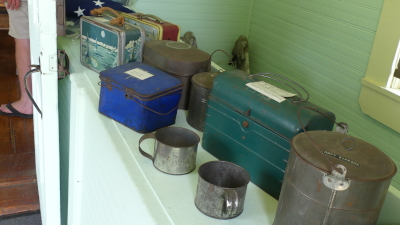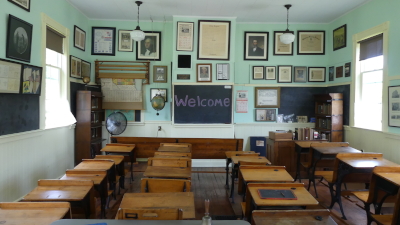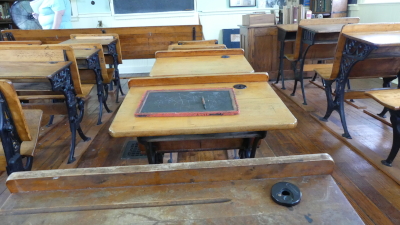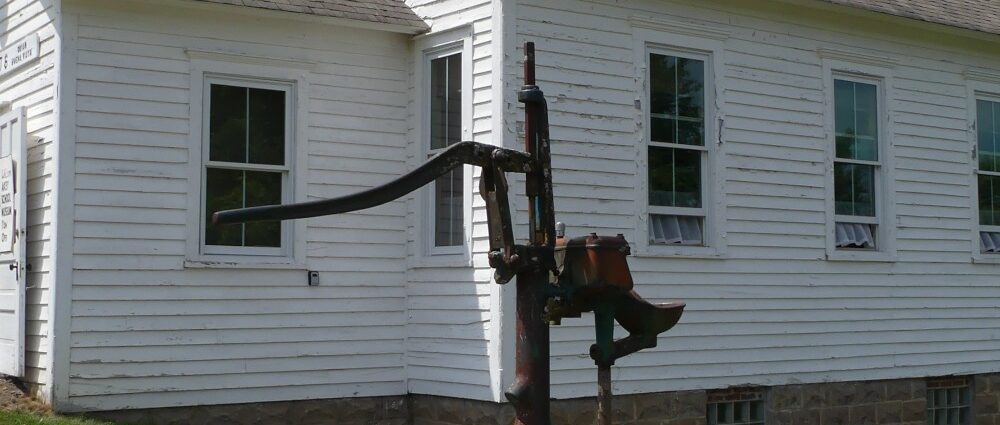Hello Everyone! Today I’m going to take you on a short little road trip. Not to be confused with one of my Dad’s “Let’s take a drive” trips.
Those were hours long and covered most of the county. Today, I promise, we are only taking a short little trip from the house I grew up in, maybe five miles down a couple of back country roads.
We are going to visit the Akey School Museum. The Akey School once was just one of over one hundred one room schools and eight graded schools (these were two room schools that had a ‘little’ room that had grades 1-4 and a ‘big’ room that had grades 5-8) that existed in Richland County. Now the Akey School is a museum that anyone and everyone can enjoy and learn from. It is open on Sunday afternoons from 1-4pm from June thru September. It is located on County Highway TB between Gotham and Twin Bluffs, a scenic Sunday drive in the heart of the Driftless Wisconsin.
Here we are. I told you it would be a short trip, only about fifteen minutes from my old home. From the outside, it looks like a plain white clapboard building. It reminds me a whole lot of the school from the television show Little House on the Prairie. Do you remember that show? Miss Beadle was the teacher, and the students walked from the surrounding area to come to the school. The same thing happened here in Richland County Wisconsin. A school board would be formed, a centralish location would be chosen for the school, a teacher would be hired, and a school was born. Akey School started in 1851. After being housed in a few different buildings, the current building was built and then later moved across the road to its present location here on County TB in rural Richland County.
 Let’s step inside so you can see what it looks like. In the entryway, there are hooks for the students to hang their coats and shelves where they can put their lunches, hats, mittens, and other things. Right by the door of the classroom is the rope to pull to ring the bell and a water crock that the teacher or one of the older boys would fill every morning and afternoon as needed from the pump in the school yard. Do you remember on Little House on the Prairie that there were just two rows of two-seater desks and they doubled as pew on Sunday? Well, here we have four rows of single seat desks. The teacher’s desk is just off to the right at the front of the room, and there are bookcases in all four corners. There is even a globe that is on a pulley so it can be raised out of the way so that students can see and use the chalk board or brought down to the students level for a lesson.
Let’s step inside so you can see what it looks like. In the entryway, there are hooks for the students to hang their coats and shelves where they can put their lunches, hats, mittens, and other things. Right by the door of the classroom is the rope to pull to ring the bell and a water crock that the teacher or one of the older boys would fill every morning and afternoon as needed from the pump in the school yard. Do you remember on Little House on the Prairie that there were just two rows of two-seater desks and they doubled as pew on Sunday? Well, here we have four rows of single seat desks. The teacher’s desk is just off to the right at the front of the room, and there are bookcases in all four corners. There is even a globe that is on a pulley so it can be raised out of the way so that students can see and use the chalk board or brought down to the students level for a lesson.
 The teacher made a daily/weekly schedule that allowed him or her to teach all eight grades all subjects: math, spelling, grammar, history, science, and penmanship. Some times it was easier to juggle the schedule than others, as there were years when there would not be students for every grade level. That gave the teacher more time for each subject and grade level. The older students often had more alone study time than the younger ones, or were sometimes expected to help the younger students with their lessons. If you look at the wall on the left side of the room, you can see a copy of what the schedule for the day might have looked like for the students here. I don’t mind any of the classes on the schedule except for science. Ick!! Never did like that class much! One might think that eight grade in one room would be chaos, and there were days like that I would guess, but, for the most part things were pretty clam. There was even a hidden benefit- by the time a first grader reached eighth grade, they had heard many of the lessons and had a good idea of what they would be learning. In addition, once radios and electricity were available, the Wisconsin Public Broadcasting System made art and music lessons available to the rural schools via their radio broadcasts. Can you imagine learning to sing a song by listening to the radio? Or learning to draw or paint? I mean, I have a pretty good singing voice, so I could probably learn to sing a song that way. But, I am pretty sure that my artistic attempts would not have gone past stick figures and lollipop trees!
The teacher made a daily/weekly schedule that allowed him or her to teach all eight grades all subjects: math, spelling, grammar, history, science, and penmanship. Some times it was easier to juggle the schedule than others, as there were years when there would not be students for every grade level. That gave the teacher more time for each subject and grade level. The older students often had more alone study time than the younger ones, or were sometimes expected to help the younger students with their lessons. If you look at the wall on the left side of the room, you can see a copy of what the schedule for the day might have looked like for the students here. I don’t mind any of the classes on the schedule except for science. Ick!! Never did like that class much! One might think that eight grade in one room would be chaos, and there were days like that I would guess, but, for the most part things were pretty clam. There was even a hidden benefit- by the time a first grader reached eighth grade, they had heard many of the lessons and had a good idea of what they would be learning. In addition, once radios and electricity were available, the Wisconsin Public Broadcasting System made art and music lessons available to the rural schools via their radio broadcasts. Can you imagine learning to sing a song by listening to the radio? Or learning to draw or paint? I mean, I have a pretty good singing voice, so I could probably learn to sing a song that way. But, I am pretty sure that my artistic attempts would not have gone past stick figures and lollipop trees!
 This may seem like the teacher had some free time in the day, but, in reality the teachers had little if any free time while at school. Every teacher had to sign a contract that spelled out their responsibilities. Each teacher had to clean the classroom, make lesson plans, help plan community events like spelling bees and programs to demonstrate what the students had learned at different times during the school year, grade papers and tests, and meet with the parents of the students, the school board, and superintendent. The contracts even included that the fire needed to be maintained during the winter and coal or wood obtained before supplies ran low. There were even contracts that spelled out how they were to dress, establishments that they could and could not go to and with whom, and what time they were expected to be home every night. Yup! Teachers had a curfew because typically they were single and were expected to set an example for the students of the school.
This may seem like the teacher had some free time in the day, but, in reality the teachers had little if any free time while at school. Every teacher had to sign a contract that spelled out their responsibilities. Each teacher had to clean the classroom, make lesson plans, help plan community events like spelling bees and programs to demonstrate what the students had learned at different times during the school year, grade papers and tests, and meet with the parents of the students, the school board, and superintendent. The contracts even included that the fire needed to be maintained during the winter and coal or wood obtained before supplies ran low. There were even contracts that spelled out how they were to dress, establishments that they could and could not go to and with whom, and what time they were expected to be home every night. Yup! Teachers had a curfew because typically they were single and were expected to set an example for the students of the school.
 Are you wondering how this museum came to be and why I wanted to bring you here today? Let me tell you that part of the story. You see, back in 1975 there was a push to preserve history because of the up coming Bi-Centennial celebrations in 1976. Because of this a group of citizens got together in in Richland County to find a suitable project. It was decided that making a one room school into a museum would be the project. Now, given that there were over one hundred schools to choose from this should be easy right? Wrong. Many of the buildings by this time had fallen into pretty bad disrepair, or been repurposed as homes, chicken coops, or pig pens. Finally Akey School was visited and found to be in great condition. Akey School was owned by the Pauls family who had maintained it after it’s closure in 1960. After talking with the Bi-Centennial committee the Pauls family decided to donate the property to the Historical Society and the county, on the condition that a park be created around it and that the society and county maintain it and pay for the upkeep of the grounds and school. This has been done through bequests, gifts, and fundraisers like ice cream socials throughout the years.
Are you wondering how this museum came to be and why I wanted to bring you here today? Let me tell you that part of the story. You see, back in 1975 there was a push to preserve history because of the up coming Bi-Centennial celebrations in 1976. Because of this a group of citizens got together in in Richland County to find a suitable project. It was decided that making a one room school into a museum would be the project. Now, given that there were over one hundred schools to choose from this should be easy right? Wrong. Many of the buildings by this time had fallen into pretty bad disrepair, or been repurposed as homes, chicken coops, or pig pens. Finally Akey School was visited and found to be in great condition. Akey School was owned by the Pauls family who had maintained it after it’s closure in 1960. After talking with the Bi-Centennial committee the Pauls family decided to donate the property to the Historical Society and the county, on the condition that a park be created around it and that the society and county maintain it and pay for the upkeep of the grounds and school. This has been done through bequests, gifts, and fundraisers like ice cream socials throughout the years.
 Now that they had a building, they needed to gather all of the necessary materials to turn it back into a school and believe it or not, this is where my Dad got more involved. My Dad, Harold Pauls, and a few others started to go to auctions, estate sales, library sales, and garage sales to find books, maps, desks, bookcases, and all kinds of other school materials. They would spent weeknights and weekends hunting for the different materials and then brought most of them to our house storing them in the garage. They documents where and from whom they got everything. They got so many desks and pieces of furniture and boxes of books and other materials, that there was no room in our two car garage for a car! In fact, even the three of us kids had a hard time squeezing through on the paths that they had left to get to different items. They met several times to sort through the materials that they had to discard the items that were in poor condition. My mom couldn’t wait for the museum to be ready for the items because she wanted the garage back! Do you see those two bookcases up front with the glass fronts? I remember at least one of those being at our house. And those two desks that are joined over there on that side of the room? And that rack of maps on the front wall? They were at our place too.
Now that they had a building, they needed to gather all of the necessary materials to turn it back into a school and believe it or not, this is where my Dad got more involved. My Dad, Harold Pauls, and a few others started to go to auctions, estate sales, library sales, and garage sales to find books, maps, desks, bookcases, and all kinds of other school materials. They would spent weeknights and weekends hunting for the different materials and then brought most of them to our house storing them in the garage. They documents where and from whom they got everything. They got so many desks and pieces of furniture and boxes of books and other materials, that there was no room in our two car garage for a car! In fact, even the three of us kids had a hard time squeezing through on the paths that they had left to get to different items. They met several times to sort through the materials that they had to discard the items that were in poor condition. My mom couldn’t wait for the museum to be ready for the items because she wanted the garage back! Do you see those two bookcases up front with the glass fronts? I remember at least one of those being at our house. And those two desks that are joined over there on that side of the room? And that rack of maps on the front wall? They were at our place too.
I have to confess that I had a reason for wanting to share this little spot with you. I’ve mentioned before that my Dad was a teacher. In fact, he was a Social Studies teacher for mostly fourth, fifth, and sixth grades. He went to school in several different one room schools here in Richland County before going to the Richland Center High School and then the Richland County Normal School where he got his teachers license. His first jobs were in one room and graded schools right here in Richland County. He took great pride in being part of this project that showed a part of his beginning in his profession. I just wanted a chance to show you a little bit of something that I had gotten to share with him.
By Marilu Miller


